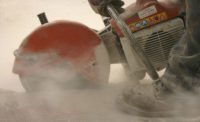California’s Safe Drinking Water and Toxic Enforcement Act of 1986, aka Proposition 65 (Prop 65) was revised August 30, 2018. The revised Prop 65 requires a warning label, example shown below, for any consumer product containing any of the more than 950 chemicals known to the State of California to cause cancer or birth defects.
Label dilemma
Manufacturers that produce or ship products into California are responsible for Prop 65 compliance. This can be a challenge. Many manufacturers aren’t sure where products will end up. In the global economy a product manufactured in Paris, TX may go to a distribution warehouse in Paris, TN and from there be sent to end-users in Perris CA, Paris, France – or anywhere.
Many companies provide the new Prop 65 label to each of their applicable products – whether the products go into California or not – to defend against overzealous bounty-hunters. Any individual acting in the public interest may file a lawsuit against a business alleged to have violated Prop 65. This so-called bounty-hunter provision allows their attorney to collect attorney fees and costs. Companies must prove exemption or compliance with Prop 65. It’s a burden that costs time and often large financial outlays.
Is Prop 65 too much?
Prop 65 provides Californians with board awareness of chemical exposure to carcinogens and also chemicals that may cause birth defects. These are the two hottest buttons for chemical health hazards. Revised Prop 65 requires, for example, specific warnings for chemical exposures from:
- Alcoholic beverages, food, prescription drugs, dental care, wood dust, furniture products, diesel engines, passenger and off-highway motor vehicles, and recreational vessels;
- Enclosed parking facilities, amusements parks, restaurants, petroleum products, service stations and vehicle repair facilities, designated smoking areas, dental offices, hotels, apartments and other residential rental properties; and
- Other specific warnings may be added over time.
My visit to California, from my home state of Ohio, earlier this year supports, albeit a small survey, that Californians are not overwhelmed by Prop 65 warnings. I asked a hotel maintenance employee about the Prop 65 warning posted at the entrance to the hotel’s elevator. He didn’t downplay the warning. It was important to him. He mentioned it should be important to me, too. Similar support for Prop 65 came from workers at the rental car agency, gas station and restaurants I visited. Californians understand Prop 65.
But what happens when the Prop 65 warning label shows up on products used elsewhere in the world?
Consumer v. workers
Toxicologically, there’s a big difference between risks to “consumers” and “workers.” Consumers include newborns, children and very old adults; some may have limitations or health conditions predisposing them to harmful effects from very low chemical exposures, such as lung disease.
Workers, however, are generally classified as “healthy working adults.” Workers generally may be exposed to a much larger dose of a chemical than consumers before harm may occur. Almost everyone knows you don’t give an adult dose of medicine to a baby, for example.
Chemical exposure limits commonly used in the United States, such as the PEL, REL, or TLV®, are established for workers. Except for U.S. EPA ambient air quality standards, there are no comparable airborne chemical exposure limits for consumers or the public. Exposure risk to the public, therefore, is usually chemical avoidance or as low as reasonably practical.
Flash in the pan?
Prop 65’s 1985 law caused a flurry of activity by manufacturers both within and outside the State of California, much like what’s happening now. Prop 65 labels were common on products wherever and Prop 65 warnings were commonplace on manufacturer safety data sheets (SDSs). Initial flurry subsided to ho-hum activity by about 1990. Will a similar activity pattern occur with the 2018 Prop 65? The activity pattern may be different this time.
Dr. Google
A clue to why a rise of concern may be greater and longer with the 2018 version of Prop 65 is found with the www.P65Warnings.ca.gov link required with new labels. The Prop 65 warning web-link, for example, takes anyone into every aspect and detail of Prop 65 – and beyond. Going online to learn and/or engage is how things are done today, particularly for Millennials and Gen Z population.
Cancer and birth defect warnings are the two hottest buttons among the range of health effects from chemical exposure. Everyone knows someone close -- a family member, friend or co-worker -- that had or has cancer.
Chemicals that may cause birth defects are addressed much differently today than back in 1985-1990. Most Millennials and Gen Z populations, the people most likely to be concerned with pregnancy and birth defects, primarily get health or medical questions answered first online by Dr. Google, before contacing their personal physician. The many Dr. Googles may give calming or wildly alarming advice. That’s the nature of things today.
Role for pros
Prop 65 is a hazard warning. Hazard means something that may cause a problem. Risk is the likelihood that a hazard will cause a problem. Prop 65 encourages employers to determine the likelihood that worker exposure to their product will cause cancer or birth defects.
With occupational health and safety professional assistance, risk is acceptable when chemical exposure(s) comply and conform to current PELs, RELs, and TLVs®. In the absence of these limits, other limits may be used to establish acceptable risk. OHS pros with credentials such as the CIH® may apply professional judgment when exposure limits may be inadequate or lacking.




